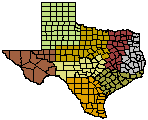- Trans Pecos
- High Plains/Panhandle
- Cross Timbers
- Hill Country
- Post Oak Savannah
- Pineywoods
- Oak Prairie
- South Texas Plains

Wildlife Division District Map
Oak-Prairie Wildlife Management
Historical Perspective
The Oak-Prairie wildlife district, as the name implies, spans parts of 2 different ecoregions. The northern third of the district consists of what is typically considered Post Oak Savannah, whereas the remainder of the district lies in the Coastal Prairies. This is an ecologically diverse part of Texas, and pockets of habitat more characteristic of South Texas brush country and the Pineywoods can even be found in the western and eastern reaches of the Oak-Prairie district, respectively.
The original savannahs in the northern part of the Oak-Prairie region were characterized by native grasses such as little bluestem, silver bluestem, and brownseed paspalum with scattered clumps of trees. Post oak trees dominated, but other species included blackjack oak, water oak, winged elm, hackberry, and yaupon. Fire working in concert with other factors such as drought, herbivory, and competition from grasses restricted shrub and tree growth and maintained the savannah. The natural fire frequency on level to rolling topography appears to have ranged from 5 to 10 years and on topography dissected with breaks and rivers the fire frequency may have been 20 to 30 years. Since the early 1800s, the suppression of fire, and soil disturbance and land clearing practices by farmers and ranchers have resulted in a higher density of smaller trees and more thick undergrowth of vegetation, especially yaupon. Bottomlands in the early 1800s were typically composed of large hardwoods with very little understory vegetation. Many bottomlands have now been cut over and cleared. Others have thick understories resulting from timber cutting or various soil disturbances, or are relatively open due to continuous grazing. According to written accounts from early explorers and settlers in 1800s, white-tailed deer, wild turkey, bison, black bear, squirrel, mountain lion, and red wolf were once common in the Post Oak Savannah.
The most striking change to the savannah has been the degradation or loss of the native range grasses from overgrazing and the clearing of the native range to plant monocultures of improved grasses, such as coastal Bermudagrass, for cattle. The rich diversity of grasses and weeds in the native savannah provided food and cover for many wildlife species and the conversion to "improved pastures" is responsible for the decline and even disappearance of species such as the bobwhite quail in much of the area.
The Coastal Prairie of Texas is a tallgrass prairie similar in many ways to the tallgrass prairie of the Great Plains. It is estimated that, in pre-settlement times, there were nine million acres of Coastal Prairie, of which 6.5 million acres were in Texas. Today less than one percent of the Coastal Prairie remains.

Little Bluestem.
Nearly 1,000 plant species have been identified in the Costal Prairie, but no one knows how many species have followed the prairie vole and the Louisiana Indian paintbrush to extinction. The Coastal Prairie historically was home to herds of bison and pronghorn antelope, and red wolves roamed among the riverine forests that crisscrossed the area. Coastal Prairie and its adjacent marsh habitat provide immense space for waterfowl and thousands of other forms of wildlife. Even in its altered state, Coastal Prairies routinely host more red-tailed hawk, northern harriers, white ibis, and white-faced ibis than any other region in the United States. The Coastal Prairie is home to the federally endangered Attwater's prairie chicken (North America's most endangered bird) and is the exclusive wintering ground of the whooping crane.
Whereas factors such as soil type and rainfall contribute to the formation of a prairie, fire is the natural mechanism by which prairie renews itself. Fire prevents woody plants from establishing, stimulates seed germination, replenishes nutrients, and allows light to reach young leaves. Historically, prairie fires occurred in the summer as a result of lightning strikes, and the fires, along with drought and competition from herbaceous plants, prevented the establishment of woody plants to maintain a grass-dominated ecosystem.
Although much of the prairie has been converted to improved pasture for cattle grazing, the majority has been altered for growing rice, sugarcane, forage, and grain crops. Much of the Coastal Prairie that remains in Texas is because it was used for cattle production and never plowed. Many species, however, have been lost through overgrazing. Continued threats to what remains of the Coast Prairie include conversion to other kinds of agriculture and development. Most remnants are privately owned with only a small percentage preserved on government land. The prairie remnants that escape conversion or paving face overgrazing or becoming overgrown with shrubs due to the suppression of fire.
Like most of Texas, the future of the Post-oak Savannah and Coastal Prairies is in the hands of the private landowners. The good news is that landowners are becoming increasingly interested in wildlife and habitat management. More landowners earn income from other professions and depend less on the land for making a living. The major challenge is that land ownership is becoming increasingly fragmented. With each generation of our growing population, ranches and farms get smaller. Most landowners no longer own enough acreage to effectively manage for wildlife without cooperating with their neighbors. The solution is Wildlife Management Associations, also known as Wildlife Co-ops, which are groups of local landowners working together for their common wildlife interests. The Oak-Prairie Wildlife District leads the state in Wildlife Co-ops and the future of wildlife in this region of Texas depends largely of their success.
References:
Rideout, D. W. 1994. The post oak savannah deer herd: past, present, future. Texas Parks and Wildlife Department Publication PWD RP W7100-237B (9/94), Austin, Texas, USA.
Grafe, V., L. Allain, M. Vidrine, C. Allen, and S. Johnson. 2000. Paradise Lost? the coastal prairie of Louisiana and Texas. U.S. Fish and Wildlife Service Pamphlet, Arlington, Virginia, USA.